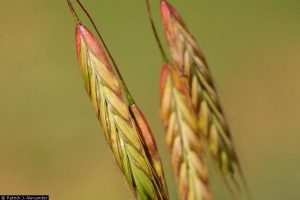Fuels & Fuel Treatments
View the brief.
Katherine Zeller, a research biologist with the Aldo Leopold Wilderness Research Institute housed within the Rocky Mountain Research Station, was part of a team of researchers who created a series of species distribution models to determine whether this concern was warranted. “What we wanted to know is how these conifer treatments might affect a greater suite of species,” she explains. “Not just the sage grouse but these other species of conservation concern.”
The Basic Identification of Grasses two-day short course covers the unique taxonomy of about 50 different grasses and grass-like plant genera. This class is for beginner through intermediate agrostologists and will include basic terminology, dissection, and use of a dichotomous key for identification. You will also learn how to collect and press grasses for future reference or for the purpose of mailing to others for identification/verification. The class may be taken for 1 unit of optional credit at the University of Nevada, Reno (UNR).
When: Class will be March 14-15 OR 16-17, 2022
Where: 300G of Fleischman Agriculture, University of Nevada, Reno
How: Sign up by contacting the instructor, Arnold (Jerry) Tiehm | Atiehm@att.net | 775-742-9180. Be sure to include your preferred class date and indicate whether or not you want to receive class credit.
Cost: $ 150 for non-students, $ 80 for students. Bring cash or check (made to Board of Regents) to the first day of class.
Details: Class will be 8 am -5 pm with a one-hour lunch break. Tea and coffee will be provided.
Vegetation dynamics models: Comprehensive set for natural resource assessment and planning in the US
View article.
These products establish the first comprehensive national baseline for measuring vegetation change in the USA, providing land managers and policymakers with a tool to support vegetation restoration and fuel management activities at regional to national scales. Users have applied these products to support a variety of land management needs including exploring ecosystem dynamics, assessing current and desired conditions, and simulating the effects of management actions. In an era of rapid ecological change, these products provide land managers with an adaptable tool for understanding ecosystems and predicting possible future conditions.
View article.
Using two designed experiments from a central Oregon juniper woodland, we resampled slash piles and skid trails 8 years after seeding. Our objectives were to assess the long-term vegetation response to conifer removal, ground disturbance, and seeding source (cultivar and local) in slash piles and skid trails. We found that seeded species persisted in the long term, but abundance patterns depended on the species, seed source, and the type of disturbance. In general, there were more robust patterns of persistence after pile burning compared to skid trails. Seeding also suppressed exotic grass cover in the long term, particularly for the local seed source. However, the invasion levels we report are still problematic and may have impacts on biodiversity, forage and fire behavior. Our short-term results were not predictive of longer-term outcomes, but short- and long-term patterns were somewhat predictable based on species life history traits and ecological succession. The use of a mix of species with different life history traits may contribute to seeding success in terms of exotic grass suppression. Lastly, our results suggest that locally adapted seed sources may perform as well or better compared to cultivars. However, more aggressive weed treatments before and after conifer removal activities and wider seeding application may be needed to effectively treat exotic grass populations.
Salvage Science Summit Fall 2021 – Panel Discussion Day 1
Salvage Science Summit Fall 2021 – Panel Discussion Day 2
View article.
Sage-grouse increasingly selected areas closer to conifer removals and were 26% more likely to use removal areas each year after removal. Sage-grouse were most likely to select areas where conifer cover had been reduced by ≤10%. The proportion of available locations having a high relative probability of use increased from 5% to 31% between 2011 and 2017 in the treatment area and locations with the lowest relative probability of use decreased from 57% to 21% over the same period. Dynamics in relative probability of use at available locations in the control area were stochastic or stable and did not demonstrate clear temporal trends relative to the treatment area. Targeted conifer removal is an effective tool for increasing usable space for sage-grouse during the breeding season and for restoring landscapes affected by conifer expansion.
Webinar recording.
This 1-hour webinar presents findings from a recently completed study, which was funded by the Joint Fire Science Program, on landscape fuel treatment effectiveness within recent large wildfire events in north-central Washington State. It provides an overview of climate change and wildfires and the imperative for broad-scale adaptive management to increase landscape and community resilience to future wildfires. Then reports findings on the effects of prior fuel reduction treatments, biophysical environment, and weather on fire severity. The study also evaluated fireline effectiveness and how past fuel treatments assisted in safe and effective response.
Webinar recording for Day 1.
Webinar recording for Day 2.
Climate change in the Great Basin poses many challenges to land management. This webinar series will discuss recent research and observations of climate and drought-driven changes in pinyon-juniper woodland dynamics. Tune in to better understand what changes may be in store. These one-hour webinars will begin at 11 PST/12 MST.
Day 1: Recent Pinyon-Juniper Responses to Climate Change
Great Basin pinyon-juniper responses to climate change: Woodland expansion, contraction, or transformation? – Peter Weisberg, UNR
PJ woodland management changes after two decades of drought: Perspective from Four Corners – Ian Barrett, BLM
Q&A and discussion
Day 2: Understory Response and Management Implications
Fire impacts in pinyon-juniper woodlands: Recovery, plant invasions, and restoration opportunities – Ali Urza, USFS
Anticipating future climate-driven changes in pinyon-juniper woodlands – Bob Shriver, UNR
Q&A and discussion
Webinar recording.
The Nature Conservancy (TNC) in Idaho recently partnered with GS Strategy Group to conduct a public opinion survey in North Idaho to gauge public perceptions on forest health, wildfire, controlled burning, and climate change. Please join for a virtual presentation and discussion of the results. Kari Kostka, Director of External Affairs for TNC and IFRP Board member, will join Robert Jones, Partner with GS Strategy Group, to share the results and answer questions.
View article.
Based on our review of the scientific evidence, a range of proactive management actions are justified and necessary to keep pace with changing climatic and wildfire regimes and declining forest heterogeneity after severe wildfires. Science-based adaptation options include the use of managed wildfire, prescribed burning, and coupled mechanical thinning and prescribed burning as is consistent with land management allocations and forest conditions. Although some current models of fire management in wNA are averse to short-term risks and uncertainties, the long-term environmental, social, and cultural consequences of wildfire management primarily grounded in fire suppression are well documented, highlighting an urgency to invest in intentional forest management and restoration of active fire regimes.





